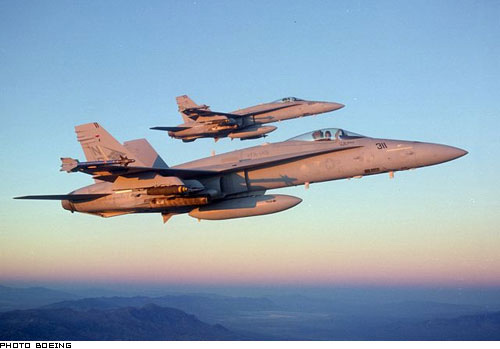F/A-18 Hornet
Summary
| Category | Combat Aircraft |
| Origin country | 🇺🇸 United States |
| Manufacturer | McDonnell Douglas |
| First flight | 18 November 1978 |
| Year introduced | 1983 |
| Number produced | 1480 units |
| Average unit price | $29 million |
Description
The McDonnell Douglas F/A-18 Hornet emerged from the U.S. Navy's requirement in the 1970s for a lower-cost, multirole aircraft to replace aging A-4, A-7, and F-4 airframes. Following a congressional mandate to evaluate competitors from the Air Force's Lightweight Fighter program, the Navy selected the Northrop YF-17 prototype. McDonnell Douglas, with its expertise in carrier aircraft, was partnered with Northrop to extensively redesign the YF-17 for naval operations. This involved strengthening the airframe and undercarriage, adding folding wings and a tailhook, increasing fuel capacity, and installing the first digital fly-by-wire system in a production fighter. This development was not without challenges, including a notable legal dispute between the two manufacturers over export sales, which was settled in 1985. The first F/A-18A flight occurred on November 18, 1978, leading to a production run that delivered 1,480 A/B/C/D variants until manufacturing ceased in 2000.
The F/A-18 is a twin-engine, mid-wing tactical aircraft renowned for its exceptional maneuverability and high angle-of-attack performance, achieved through features like large leading-edge extensions (LEX), canted vertical stabilizers, and a sophisticated digital fly-by-wire system with quadruple redundancy. Its cockpit design was pioneering, making extensive use of multifunction displays that allowed a single pilot to seamlessly switch between fighter and attack roles. It was also the first Navy aircraft to incorporate a digital multiplexing avionics bus, facilitating easier upgrades. A key design principle was ease of maintenance; the General Electric F404 engines were engineered for exceptional reliability and could be replaced by a four-person team in under 20 minutes, significantly reducing downtime compared to its predecessors.
The Hornet is armed with an internal 20mm M61A1 Vulcan cannon and features nine external hardpoints capable of carrying up to 13,700 pounds of ordnance and external fuel tanks. The aircraft's weapon systems support a comprehensive multirole capability. For air-to-air combat, it can be armed with AIM-9 Sidewinder, AIM-7 Sparrow, and AIM-120 AMRAAM missiles. Its air-to-surface loadout is extensive, including AGM-65 Maverick missiles, AGM-88 HARM anti-radiation missiles, and stand-off weapons like the AGM-84H/K SLAM-ER. Furthermore, it is capable of deploying a wide range of munitions such as Joint Direct Attack Munition (JDAM) kits, Paveway laser-guided bombs, and conventional Mk 80 series bombs, supported by targeting pods like the AN/AAS-38 NITE Hawk or LITENING for precision strikes.
Entering service with the U.S. Marine Corps in 1983 and the U.S. Navy in 1984, the Hornet first saw combat during operations against Libya in 1986. Its versatility was prominently demonstrated during the 1991 Gulf War, where it successfully engaged and destroyed enemy fighters before proceeding to strike ground targets on the same sortie, establishing records for aircraft availability and reliability. The aircraft has served continuously in numerous global theaters, including Bosnia, Kosovo, and Iraq. In addition to its service with U.S. forces, the F/A-18 has been a critical asset for the air forces of several nations, including Australia, Canada, Finland, Spain, and Switzerland. While the U.S. Navy retired its final active-duty F/A-18C in 2019, the Hornet continues its service with the U.S. Marine Corps and international operators.
Main Variants
- F/A-18A: The original single-seat, carrier-capable multirole fighter and attack aircraft.
- F/A-18B: A fully combat-capable, two-seat variant of the F/A-18A, primarily utilized for pilot training.
- F/A-18C: An upgraded single-seat model featuring improved radar, modern avionics, and compatibility with advanced munitions like the AIM-120 AMRAAM missile.
- F/A-18D: The two-seat version of the F/A-18C, often configured with a specialized rear cockpit for a Weapons and Sensors Officer in all-weather strike roles.
- F/A-18E/F Super Hornet: An extensively redesigned and larger successor, featuring a new airframe, more powerful engines, and upgraded avionics.
Technical specifications
| Version: F/A-18C/D | |
|---|---|
| Crew | 1 (C) or 2 (D) |
| Operational range | 2,017 km (1,253 mi) |
| Maximum speed | 1915 km/h (1190 mph) |
| Wing area | 38 m² (409.0 sqft) |
| Wingspan | 12.3 m (40.4 ft) |
| Height | 4.7 m (15.4 ft) |
| Length | 17.1 m (56.1 ft) |
| Service ceiling | 15,000 m (49,213 ft) |
| Empty weight | 10,433 kg (23,001 lbs) |
| Max. takeoff weight | 23,541 kg (51,899 lbs) |
| Climb rate | 250.0 m/s (820.2 ft/s) |
| Powerplant | 2 x General Electric F404-GE-402 afterburning turbofan engines delivering 6350 kgf each |
| Ejection seat | Martin-Baker Mk 14 |
Current operating countries
| Country | Units | ||
|---|---|---|---|

|
United States | 378 | |

|
Canada | 92 | |

|
Spain | 81 | |

|
Finland | 61 | |

|
Australia | 36 | |

|
Kuwait | 35 (+28) | |

|
Switzerland | 30 | |

|
Malaysia | 8 | |
All operators
Armament
Missiles payload:
- Anti-Radiation AGM-88 HARM
- Air-to-Air Medium-Range AIM-120 AMRAAM
- Air-to-Surface Raytheon AGM-154 JSOW

